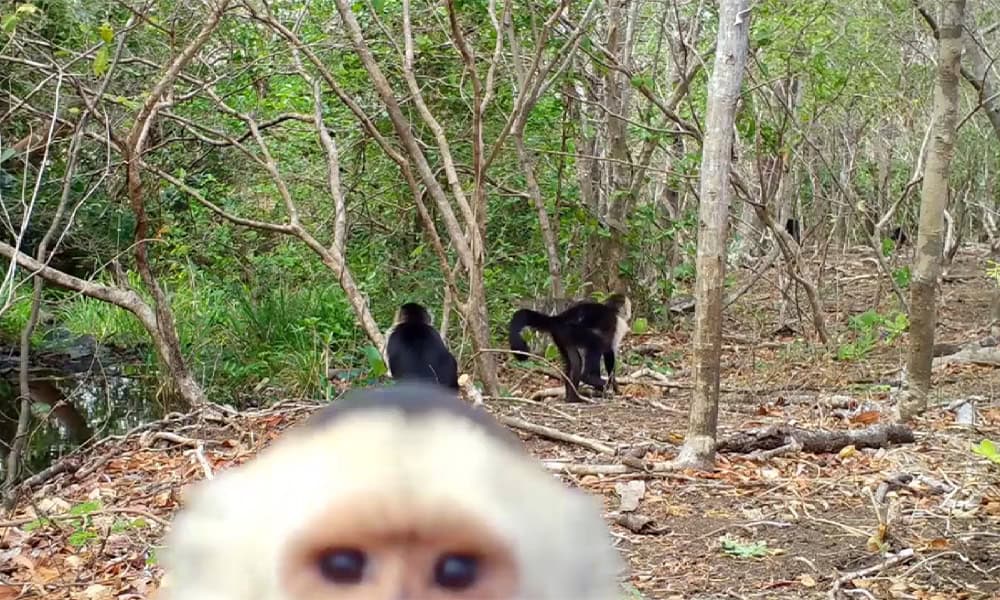How wildlife behaves depends on the circumstances of the interaction. Everybody wants to go for a hike and see wild animals with their very own eyes in the habitat that they live in. To some degree, this is perfectly possible. There are some species that you stand almost no chance of seeing and others that you have a much higher probability of catching a glimpse of in nature. A glimpse is mostly likely what you’re going to get. Most wildlife interactions in person consist of the person feeling a little excited jolt in their heart and thinking, ‘Oooh! It’s a (whatever the species is)!’, and then that animal sees the person and thinks, ‘Run!’. That is to say, the animal behavior you are most likely to witness is an animal being startled by your presence.
Seeing something like an ocelot bolt away from you in fear is a perfectly wonderful turn of events. Beggers can’t be choosey. I’ll take any ocelot interaction I can get but sometimes seeing something other than a fear response would be nice. Enter the magic of camera traps. These little boxes sit soundlessly in the environment, recording wild animals acting perfectly naturally in their environment. At least, that’s the idea. The dirty little secret of camera trapping is that the cameras do not blend perfectly into the background. Instead of perfectly natural behavior, many times the cameras record mostly perfectly natural behavior with a little pinch of ‘hey what’s this box doing here?’ mixed in.
Many species, from little doves to giant Baird’s tapirs, take notice of the camera traps. They are responding to some combination of factors such as the shape of the camera looks unnatural, it has a funny smell, either the plastic or my hands touching it the last time I reviewed the camera, and at night many of the cameras I use glow red to increase the video quality. Sometimes their reaction is just a second glance toward the camera, sometimes it’s much more. Here are a few species that have taken it upon themselves to have an interaction with my camera traps.
White-faced Monkeys
This should probably come as little surprise. They’re intelligent and they have tiny people-hands that they happily use to manipulate my cameras. There is one big positive and one big negative to these monkeys messing with my cameras. The negative, they push, pull, and jump on the cameras enough to break them or at least spin them around so they’re recording four square inches of the forest floor. The positive, there is nothing cuter than a video of a white-faced monkey grabbing a camera and cocking its head inquisitively at the lens.
Coyotes
Coyotes mess with my cameras in very specific circumstances. I’ve only recorded them pulling on my cameras that are attached to a tree with a cloth strap. Camera traps can be placed on trees in two different manners, pulled tightly to the tree with a cloth strap or screwed into the tree with a metal camera mount. I’ve never recorded a coyote messing with a camera on a camera mount, but there’s something irresistible about cameras tethered to the tree with cloth straps. Several times I’ve recorded coyotes running by and then returning to the camera for a quick game of tug of war with a camera strap.
Big Cats
A few times some of Costa Rica’s top feline predators decided they didn’t like the way my cameras were looking at them. Twice I’ve recorded pumas getting right up to the camera and hissing. Both incidents took place at night, so I think they were a reaction to the camera’s lights. Just last week I recorded a jaguar interacting with a camera for the first time. It approached the camera, gave it a sniff, and then smacked it around until it was facing the ground.
Crocodiles
The interactions between American crocodiles and my cameras have probably been the biggest surprise for me. I guess I just assumed the large reptiles weren’t sophisticated enough to take any notice of the cameras. That does not seem to be the case. Twice now I’ve recorded videos of crocodiles biting my cameras. The first time, the croc approached, took a bite of the camera, knocked it over, and gave a little triumphant hiss.
The second time, the crocodile gently took the camera in its jaws and spun it around without doing any damage at all. These animal’s interactions with the cameras prove that camera traps aren’t exactly the proverbial fly on the wall, observing everything without being noticed. While I don’t love that the end result of these interactions are frequently cameras facing the wrong direction, diligently recording nothing of use for several days or weeks, it is interesting to know that a wide range of species are attuned to their environment to the degree that even a little plastic box on a tree doesn’t go unnoticed. Take a look at the video below and appreciate a few species ‘taking interest’ in my camera traps
About the Author
Vincent Losasso, founder of Guanacaste Wildlife Monitoring, is a biologist who works with camera traps throughout Costa Rica.






